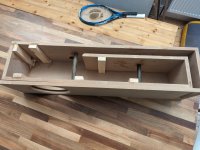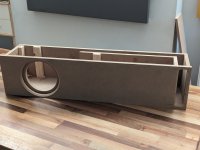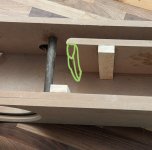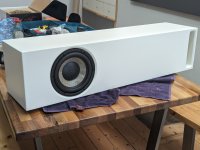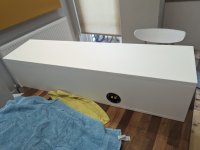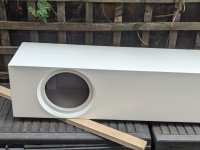Hi
Further to my previous thread, this sub design has been cut and partially glued. It's a Focal 8 inch flax cone 4 ohm driver, tuned to around 30Hz. I've added an extra panel to the front to double up thickness and recess the driver. It will sit behind a wine rack in my kitchen music system. WinIsd models it flat to 30Hz at 105dB/1m. I've bought a mini Dayton LF dsp to provide a steep high pass filter below tuning as the enclosure is twice the Focal recommended size at around 1.5 cubic feet including port space. If anyone has a cheaper or better value idea for a high pass DSP, I'll be interested in that too as I'll be able to return it easily via Amazon.
https://subbox.pro/en/b/Dma3w9kjt
I will put it all together tomorrow, and just wondered if anyone had any advice, or comments.
Specifically, regarding resonances, should I add some foam or material to soak up any higher frequencies, e.g. on the inside left panel? Or is that just a waste of time and space?
Also if someone can point me to a guide on how to crimp the speaker terminals on the inside that would be very helpful.
Thanks.
PS. Here is the thread re the room if you're interested. https://www.diyaudio.com/community/threads/new-kitchen-setup.415463/
Further to my previous thread, this sub design has been cut and partially glued. It's a Focal 8 inch flax cone 4 ohm driver, tuned to around 30Hz. I've added an extra panel to the front to double up thickness and recess the driver. It will sit behind a wine rack in my kitchen music system. WinIsd models it flat to 30Hz at 105dB/1m. I've bought a mini Dayton LF dsp to provide a steep high pass filter below tuning as the enclosure is twice the Focal recommended size at around 1.5 cubic feet including port space. If anyone has a cheaper or better value idea for a high pass DSP, I'll be interested in that too as I'll be able to return it easily via Amazon.
https://subbox.pro/en/b/Dma3w9kjt
I will put it all together tomorrow, and just wondered if anyone had any advice, or comments.
Specifically, regarding resonances, should I add some foam or material to soak up any higher frequencies, e.g. on the inside left panel? Or is that just a waste of time and space?
Also if someone can point me to a guide on how to crimp the speaker terminals on the inside that would be very helpful.
Thanks.
PS. Here is the thread re the room if you're interested. https://www.diyaudio.com/community/threads/new-kitchen-setup.415463/
Last edited:
Also, I meant to add, regarding port length, that can still be changed if the high ratio, narrow port will change the frequency. Port velocity models at less than 16ms iirc.
Winsd has similar length to the subbox pro website, but flare-it app had completely different frequency around 20Hz. 😕
I was planning to leave the port ends unflared. I may put a round-over on the vertical slot sides in the front panel/baffle but it would be a very small radius just for aesthetics.
Winsd has similar length to the subbox pro website, but flare-it app had completely different frequency around 20Hz. 😕
I was planning to leave the port ends unflared. I may put a round-over on the vertical slot sides in the front panel/baffle but it would be a very small radius just for aesthetics.
what is the upper crossover frequency?should I add some foam or material to soak up any higher frequencies, e.g. on the inside left panel? Or is that just a waste of time and space?
Foam (unless in very thick layers - we're speaking of half wavelength dimensions! And you don't even want to absorb bass frequencies in case of ported box) will only absorb rear radiated sound far above useful subwoofer crossover frequencies. So it's probably useless.
For cabinet or panel resonances: again those are probably far above the useful subwoofer passband.
Just make the enclosure stiff and include bracing to make it even stiffer and move eventual panel resonances further up.
using your numbers (16 m/s and 30 Hz) the resulting air particle displacement for the port is about 8,5 cm. For non-turbulent airflow you need a port mouth with radius of roughly 1 - 1,5 times the air particle displacement (see strouhal number in my port investigation thread), thus about 250-500 cm2 port mouth surface.I was planning to leave the port ends unflared.
I suppose that will translate into a excessively long port, thus you can either compromise on the max SPL, or accept some compression and chuffing at high levels (that's widely accepted for commercial speakers, by the way), or make flares.
Hi thanks very much.what is the upper crossover frequency?
Foam (unless in very thick layers - we're speaking of half wavelength dimensions! And you don't even want to absorb bass frequencies in case of ported box) will only absorb rear radiated sound far above useful subwoofer crossover frequencies. So it's probably useless.
For cabinet or panel resonances: again those are probably far above the useful subwoofer passband.
Just make the enclosure stiff and include bracing to make it even stiffer and move eventual panel resonances further up.
Probably crossing over 70 to 110hz depending on whether I buy an extra pair of BX1s or keep my JBL Control Ones for a while.
I've put in a little extra bracing. Will upload a photo later.
Still a bit concerned with port tuning as Box Notes is so different from winisd and the Subbox pro website. Is there any gold standard free or cheap software by which DIY audio members plan their port tuning, or should I just go with winisd?
I've put in a slight flare for aesthetics with a chamfer bit, but I suspect it's not overly useful as not a massive radius. Would you do the same on the inside edge of the port too?
Thanks very much. I hadn't heard of the air particle displacement figure. I had a look at the thread but it is long and complicated. Is there a simple formula for calculating it please so I can decide whether or not to tune higher?using your numbers (16 m/s and 30 Hz) the resulting air particle displacement for the port is about 8,5 cm. For non-turbulent airflow you need a port mouth with radius of roughly 1 - 1,5 times the air particle displacement (see strouhal number in my port investigation thread), thus about 250-500 cm2 port mouth surface.
I suppose that will translate into a excessively long port, thus you can either compromise on the max SPL, or accept some compression and chuffing at high levels (that's widely accepted for commercial speakers, by the way), or make flares.
There is quite a lot of surplus spl in the design, so I will probably leave it, but I'd like to know so I can tinker with the numbers and get a feeling for them.
At 30hz, it is quite a long port already, it would be prohibitively long with a wider slot in this build so I think I would have to tune higher.
I found a strouhal number calculator with three inputs including air velocity and frequency but not sure what to put in for characteristic length regarding ports, is it the port length?
I don't use it but as far as I know it's very useful and reliable.should I just go with winisd?
If you post TSP and your planned enclosure I can check with hornresp (very useful tool!).
Absolutely. A sharp interior end will produce modulated tube resonance chuffing noise at high levels which is very annoying!Would you do the same on the inside edge of the port too?
No need to put anything in the box for those frequencies!crossing over 70 to 110hz
Last edited:
Unfortunately, yes!I had a look at the thread but it is long and complicated.
I am still collecting data but I will make a condensed documentation soon!
I wouldn't tune higher just because of strouhal number, considering ...Is there a simple formula for calculating it please so I can decide whether or not to tune higher?
david mcbean (author of hornresp) wrote down the correct formula here:There is quite a lot of surplus spl in the design
https://www.diyaudio.com/community/...rbers-and-port-geometries.388264/post-7697492
Also, since the last two or three updates hornresp can plot the strouhal number graph.
Again, using a flared port it should be possible to make it shorter, keeping noise and compression low. See flared port calculation excel tool here:At 30hz, it is quite a long port already, it would be prohibitively long with a wider slot in this build so I think I would have to tune higher.
https://www.diyaudio.com/community/...rbers-and-port-geometries.388264/post-7699173
The "disadvantage" is you would need to 3d-print the port.
Or make it a flared rectangular port with similar cross section surface development and length. For a wide port it is preferrable to flare the port height. See here:
https://www.diyaudio.com/community/...rbers-and-port-geometries.388264/post-7627193
Last edited:
Brilliant. Thanks so much for your input.
By TSP do you mean the Thiele parameters for the driver? If so I can do so shortly. Or it's a Focal Flax Evo P20FE in case it's easier to download from loudspeaker database or if it's already in hornresp.
I've rounded off the port edges, will do a bit more tomorrow to increase the radius of the inside section and smooth out the front.
Here are some photos of current progress. I just have to glue on the front baffle (which is pictured but unglued) and then the top. Until then I could cut off some of the port if necessary...
Thanks.
By TSP do you mean the Thiele parameters for the driver? If so I can do so shortly. Or it's a Focal Flax Evo P20FE in case it's easier to download from loudspeaker database or if it's already in hornresp.
I've rounded off the port edges, will do a bit more tomorrow to increase the radius of the inside section and smooth out the front.
Here are some photos of current progress. I just have to glue on the front baffle (which is pictured but unglued) and then the top. Until then I could cut off some of the port if necessary...
Thanks.
Attachments
Should I round off the bracing too? That would take longer to file off, but could still be done.
No, it's the port mouth (exit) radius, unfortunately!is it the port lengt
Thanks, I could fashion a piece of MDF to do that.
Just to clarify, am I right in thinking this should roll all the way round to come back on itself, so the end looks like most of a cylinder?
Just to clarify, am I right in thinking this should roll all the way round to come back on itself, so the end looks like most of a cylinder?
FWIW, etc., the pioneers found that with horn tuning that a 1.0:1.273 was the upper limit.Also, I meant to add, regarding port length, that can still be changed if the high ratio, narrow port will change the frequency.
no need to do that - the important thing is that for the fast moving air at the port entrance there should be no sharp edges nearby. Once some cm or inches away from the slot port the airspeed is much lower.this should roll all the way round to come back on itself
Well, it's finished. Thanks for your help. I got it sprayed the same colour as the kitchen.
Quite pleased with the finish, but next time I'll spend more time sanding and put putty on every joint for a pristine finish.
So, looks pretty good and I learnt a few things. But, unfortunately.... the location is not working out at all, it's very boomy, and I'm lacking adequate 4.1 room correction to sort out...and it's too big for anywhere else in the room...so I will either be selling the driver or see about making/repurposing to get a smaller sealed sub for the bookshelves just to reinforce the 50-80hz range.
If I set the volume for the dining room, it's subtle and awesome. But then the kitchen sounds boomy. If I set the volume lower so it's good in the kitchen, it is too quiet to hear in the dining room. Basically the location is not working very well at all. Room correction could maybe sort it but I've already spent quite a bit of money, so I think I will just have to make do for a while unless it sounds great near the bookshelves.
I also had to set the high pass filter much higher than expected (currently around 75hz but shallow) to get rid of rattle and shake in the cupboards. Essentially the port is getting no use at all in the cabinet top position so I would have been better off with sealed anyway, and save some space and weight.
I have thought about simply reusing it in my cinema room to support my much larger sub (4.5 cubic feet Eminence Lab 12c) which is tuned around 28hz. Not sure if that's a good idea or not, even if there were a suitable space for it?
Quite pleased with the finish, but next time I'll spend more time sanding and put putty on every joint for a pristine finish.
So, looks pretty good and I learnt a few things. But, unfortunately.... the location is not working out at all, it's very boomy, and I'm lacking adequate 4.1 room correction to sort out...and it's too big for anywhere else in the room...so I will either be selling the driver or see about making/repurposing to get a smaller sealed sub for the bookshelves just to reinforce the 50-80hz range.
If I set the volume for the dining room, it's subtle and awesome. But then the kitchen sounds boomy. If I set the volume lower so it's good in the kitchen, it is too quiet to hear in the dining room. Basically the location is not working very well at all. Room correction could maybe sort it but I've already spent quite a bit of money, so I think I will just have to make do for a while unless it sounds great near the bookshelves.
I did wonder whether the kitchen speakers also need a delay. One problem I'm having is the little Dayton LF dsp has very low output voltage so I need to boost it to get decent output from the fairly weak chi-fi amp.
I also had to set the high pass filter much higher than expected (currently around 75hz but shallow) to get rid of rattle and shake in the cupboards. Essentially the port is getting no use at all in the cabinet top position so I would have been better off with sealed anyway, and save some space and weight.
I have thought about simply reusing it in my cinema room to support my much larger sub (4.5 cubic feet Eminence Lab 12c) which is tuned around 28hz. Not sure if that's a good idea or not, even if there were a suitable space for it?
Attachments
Last edited:
Did you try stuffing the port to see if sealed is any better? A simple squishy foam plug or a few pairs of socks wadded up in there will usually work.
Multiple subs are usually the best approach if you want to cover a large area with bass. Putting another sub in the dining room (and keeping the one in the kitchen) would likely even things out significantly. Room correction works well for single point listening, but it can't do as much with multiple listening locations and vastly different distances.
Putting a single sub in a central spot so there's more symmetry at the two listening positions in relation to the sub may also help.
Multiple subs are usually the best approach if you want to cover a large area with bass. Putting another sub in the dining room (and keeping the one in the kitchen) would likely even things out significantly. Room correction works well for single point listening, but it can't do as much with multiple listening locations and vastly different distances.
Putting a single sub in a central spot so there's more symmetry at the two listening positions in relation to the sub may also help.
Thanks yes I tried a big towel. Just moving it to the corner next to the bookshelf speakers and blocking the port has made a world of difference. I've used PEQ to make the response flat (on the dsp graph not real response in room) to 50hz then a steep 48db/octave with around -10db at 40hz. It is not bad at all. Just about worth keeping.
The whole system needs some kind of EQ, the dsp LF output is really too low to work well, and I need to cut the sub in half...
The whole system needs some kind of EQ, the dsp LF output is really too low to work well, and I need to cut the sub in half...
- Home
- Loudspeakers
- Subwoofers
- Preventing resonances, should I add foam or something?
